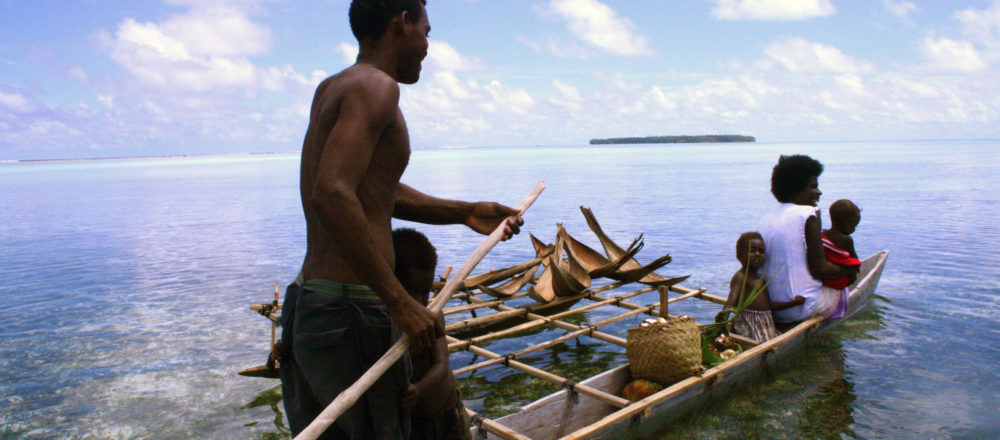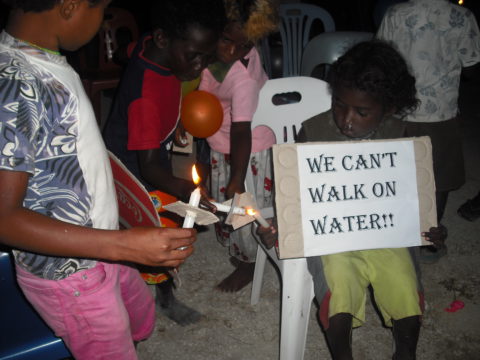This article is part of our August theme, which focuses on the environment and human rights. Read more articles on this theme.
“We Can’t Walk on Water”: this was the slogan on a poster carried by a small girl at a 2009 event connected to the annual 350.org mass public actions. The event saw the first wave of resettled families from Tulun/the Carteret Islands in Papua New Guinea gather with their new local community in Tinputz, Bougainville. The slogan dramatically illustrates the growing number of small island communities who already experience the catastrophic impact of carbon pollution and climate change on their way of life. Multiple and interacting climate dynamics, including sea level rise, storm surges, more extreme weather events, ocean warming and ocean acidification, play a part in creating forced climate migrants.
There’s a story told about the time when the British began to mine phosphate on Nauru, one of the three great phosphate rock islands of the Pacific. It was impossible for them to build a seaport because of the surrounding coral reef which became exposed at low tide. They then began to construct a cantilever for transporting the phosphate to a ship anchored offshore. To the horror of the Nauruans, the plan was to build the cantilever right across one of the limited number of small channels through the reef which allowed them access to the ocean by canoe for fishing. The right of use of the channels was determined on a clan basis. When the British brushed aside their objections, the Nauruans wondered how these people could really be human when they refused to recognise such a fundamental thing as sea access rights.
I tell this story because it illustrates for me one of the central dilemmas of responding to climate change, especially because it impacts those least responsible and most vulnerable to its ravages. Interactions with communities having to confront the radical undermining of their whole way of life because of climate-change-related forces raises the question of whether any of the multiple human rights instruments developed under the United Nations auspices are now adequate to cater to what these communities feel to be the abrogation of their fundamental rights.
Even on the basis of the original 1948 UN Declaration, the impacts of climate strike a chord. Consider for example: the right not to be subjected to arbitrary exile (Article 9); the right to protection from arbitrary deprivation of property (Article 17.2); the right to the economic, social and cultural rights indispensable for human dignity (Article 22); the right to an adequate standard of living and to livelihood security in the event of circumstances beyond a person’s control (Article 25). And finally: “Nothing in this Declaration may be interpreted as implying for any state, group or person any right to engage in any activity aimed at the destruction of any of the rights and freedoms set forth herein”(Article 30). While this destruction was clearly not the aim of the historically highly carbon polluting countries, including Australia, it is now impossible to deny that it is in fact the outcome.
For more than 10 years, Friends of the Earth Australia (FoEA) has been involved in a climate justice campaign, with a strong focus on research, education and advocacy related to the impact of climate change on vulnerable communities, especially in the Pacific Islands region. As well as facilitating speaking tours to Australia by representatives of affected Pacific communities, the campaign included the publication in 2005 of A Citizen’s Guide to Climate Refugees, revised and reissued in 2007, and a more extensive analysis of the issues in Climate Justice: A Fair Share of the Atmosphere in 2006.
It has been the ongoing relationship with Pacific Island climate change advocates that has led the comparatively small FoE Climate Frontlines group directly involved in the Pacific-focused dimension of the Climate Justice campaign to shift away from the designation “climate refugees”. While this terminology is still widely used in many research and advocacy circles, by affected communities in other parts of the world and within parts of the UN system itself, Pacific advocates find it unacceptable.
The reasons for this are many, including awareness of Australian public attitudes and government policies towards asylum seekers and refugees since the early 2000s. Of more importance, however, is the determination to have their circumstances recognised as a distinct complex of human rights issues, different from those of people fleeing persecution and whose rights were enshrined in the 1951 Refugee Convention. In its 2009 Moana Declaration, the Pacific Conference of Churches adopted the language of “forced climate migrants” to refer to people facing climate change-related displacement and resettlement. This now seems to be more acceptable terminology, at least in the Pacific.
…the determination to have their circumstances recognised as a distinct complex of human rights issues, different from those of people fleeing persecution and whose rights were enshrined in the 1951 Refugee Convention.
Among the actions called for in the declaration was the development of “the framework for a new Convention or Protocol on Resettlement to cater for the specific and unique situation of persons, communities and states affected by climatic induced catastrophes”. The declaration also called for “immediate measures to identify available land and other appropriate resources for the purposes of relocating and resettling all forced climate migrants, both those displaced internally as well as those likely to seek resettlement in other countries”. These calls were reiterated in later statements and subsequent church conferences.
The case of Tulun/the Carteret Islands
The Tulun/Carteret Islands case is significant for understanding some of the fundamental issues in a rights-based approach to climate change-related displacement and resettlement. First and foremost, it illustrates the particular challenges faced by atoll-based communities. Their unique geophysical and ecological characteristics make these communities both capable of sustaining vibrant and rich culture-specific life ways and particularly vulnerable to the impacts of global carbon pollution and climate change. The Carterets are a scattering of low-lying coral atolls in a horseshoe shape, with a maximum elevation of 1.5 metres above sea level and a population of around 2500. It has been estimated that by 2015, and certainly by 2020, Tulun will be largely uninhabitable.
It has been estimated that by 2015, and certainly by 2020, Tulun will be largely uninhabitable.
Recognition of the precarious circumstances of the islanders led the Papua New Guinean government, towards the end of 2005, to authorise their gradual evacuation to Bougainville. It took a group of Carteret chiefs to activate the process. They established an organisation called Tulele Peisa (“Sailing the Waves on Our Own”) to plan and implement the gradual resettlement of a significant proportion of their population, and recruited Ursula Rakova as its director. This resettlement program was only possible because of the donation of land belonging to the local Catholic Church in four different locations on Bougainville, previously used as income-generating cocoa plantations. The current phase of the program, begun in 2007 in Tinputz, involves building houses for 10 families, the establishment of food gardens and setting up primary education facilities.
To date, almost all the funding has come from overseas non-governmental development and church-based agencies in Europe, Australia and New Zealand, largely through the persistent efforts of the program’s director. The only governmental support has been via the Finnish Embassy in Canberra. No funds from a grant designated by the Papua New Guinea government in 2007 for resettlement purposes under the auspices of the Autonomous Bougainville Government have been made available to Tulele Peisa as yet. The regeneration of the cocoa plantation on the Tinputz site and links with a fair trade international marketing association have been initiated to provide an income source for the long-term sustainability of services for the resettled community. A poultry raising project has a similar goal.
Comments by Tulele Peisa director Ursula Rakova illustrate something of the gamut of rights under threat:
We cannot isolate human rights from environmental rights as the two will always go together. When climate change is an issue it cuts into the very fabric of society as it begins to displace peoples and communities from their customary and traditional values and accepted way of life, forcing them to move because they cannot continue to live in their home surroundings as they will either face death or be forced to move by nature.
It does not matter where people live, they still cling to their inheritance and way of life as given by their forebears. But climate change has intruded into the lives of many culturally distinct and traditional societies. Now, for example, the Carteret Islanders have moved to mainland Bougainville, not because of their own choice but because the situation is forcing them to move to safe and secure locations for the protection of their well-being and that of their children and grandchildren.
One of the biggest challenges of the resettlement program has been to build relationships with the surrounding local communities, where systems of customary land rights still prevail and when the whole province is still recovering from the impacts of a vicious and protracted civil war. Though the resettlement site is on land owned by the Catholic Church, Tulele Peisa has felt obliged to establish a relationship with the traditional landowners in accordance with customary procedures. As cases in other parts of Papua New Guinea attest, however, new population pressures and perceptions of economic interest can mean that such relationships don’t necessarily guarantee secure ownership in perpetuity.
As one way of building good relationships, Tulele Peisa plans to construct additional classrooms for the existing primary school, as well as employing local labour for construction and plantation work. An underlying advantage is that the Tulun people migrated several generations ago from Buka Island, the northern of the two main island of Bougainville autonomous province. The atoll-based populations to the east of the Carterets – the Taku’u/Mortlock Islands, the Nukumanu/Tasman Islands and the Nuguria/Fead Islands – suffering a similar climate-change-related fate, have no traditional ethnic ties to Bougainville and, for this reason, face a particularly uncertain resettlement future.
Addressing the human rights issues
In theory, many instruments exist to address concerns such as basic subsistence rights (e.g., to food and water). The right to a safe environment, including protection of land and ocean spaces from pollution and degradation, are more recent additions to the human rights agenda. Discussion of climate change-related concerns has been happening within the UN Human Rights Council, with a proposal under consideration to appoint a special rapporteur for this purpose. Very little attention has been given to date to the existing UNESCO Convention on the Protection and Promotion of the Diversity of Cultural Expressions.
In the case of the Tulun/Carteret Islands people, the availability of the option, at least in the immediate future, of resettlement on Bougainville, or “internal migration”, cushions the trauma of forced displacement. Similar internal relocations have taken place elsewhere in the Pacific, especially from small, outlying island communities in, for example, Solomon Islands and Vanuatu, and this kind of scenario is likely to increase in frequency around the Pacific as climate change impacts become more intense and destroy the possibility of a sustainable livelihood.
An even more challenging case is that of the sovereign state of Tuvalu, composed entirely of atolls, and increasingly subjected to the same climate-change-related impacts as the Carterets. Displacement of their people requires the option of resettlement in another sovereign jurisdiction. In the Pacific, Kiribati and the Marshall Islands are in similar situations. As well, with the eventual evacuation of entire national populations as a real prospect, these cases raise bigger questions of ongoing sovereign rights over land and ocean zones once they are uninhabitable on a permanent basis.
…these cases raise bigger questions of ongoing sovereign rights over land and ocean zones once they are uninhabitable on a permanent basis.
Law faculties of a number of universities have begun to address the human rights dimensions of climate change-related displacement and there have already been attempts to draft international legal instruments with this in mind. These include the Draft convention on the international status of environmentally-displaced persons , connected to the Law Faculty of the University of Limoges, with involvement of Friends of the Earth France; and The Hodgkinson Group’s draft convention to address of the rights of persons displaced by climate change with a view to establishing an international regime for the status and treatment of such persons. While it is encouraging to see such efforts and to hope that they will succeed, the sober reality is that a significant timeframe is required for such conventions to be agreed, adopted, and then implemented at the necessary political levels.
Australia’s responsibility
Attempts by the government of Tuvalu in the early 2000’s to negotiate an appropriate resettlement option in Australia, in the longer-term interest of their people’s inevitable, eventual need for a new place to call home, were a total failure. A new opening seemed possible when, on 5 January 2006, the then Federal Labor MP Bob Sercombe and current MP Anthony Albanese issued Our Drowning Neighbours, Labor’s Policy Discussion Paper on Climate Change in the Pacific, with the goal of generating a more proactive, strategic approach.
The paper addressed a wide range of concerns related to climate change in the Pacific, including the improvement of research and monitoring facilities, assistance for adaptation and emergency efforts, and assistance with “intra-country evacuations”. It also recognised that special measures needed to be taken to address the situation of countries like Tuvalu:
Labor believes that Australia should, as part of an international coalition, do its fair share to accept climate change refugees as part of our humanitarian immigration program. Yet Australia needs to work with our Pacific neighbours to prepare for such contingency now… Firstly, Australia should help to develop a coalition of Pacific Rim countries willing to accept climate change refugees. Secondly, Australia should be working at the UN to ensure appropriate recognition of climate change refugees in existing conventions, or through the establishment of a new convention on climate change refugees.
When Labor came into power in 2007, it signed on to the UN Framework Convention on Climate Change’s Kyoto Protocol, as a signal of a commitment to global effects to mitigate carbon pollution. Its focus since then in relation to climate change in the Pacific has been on research and technology transfer related to adaptation, disaster preparedness, and financial support in view of current and future potential impacts. In Engaging our Pacific Neighbours on Climate Change, the document prepared by the Australian Government in preparation for the annual Pacific Islands Forum meeting, hosted by Australia in Cairns in 2009, only one page is devoted to issues of displacement, with a strong emphasis on “the possibility” of a need for permanent migration sometime in the future, and on the fact that climate change is often one of a complex of factors driving migration.
This approach is clearly inadequate, especially in view of the latest scientific evidence and predictions about climate change scenarios. Our Drowning Neighbours provides a well-researched overview of the Pacific Islands situation in the face of climate change and a framework for meaningful, strategic measures to prepare now for climate change-related displacement and resettlement. It could serve as the impetus for an urgently needed cross-sectoral task force, organised and funded by Australia, including representation of governments, scientific and human rights experts, spokespeople from already affected communities, civil society advocates and funding agencies. The hoped for outcome would be the development of decent, dignified and culturally-sensitive model like that of Tulele Peisa, fully incorporating Australia’s responsibility to its neighbours.
Wendy Flannery convenes the Climate Frontlines collective of Friends of the Earth Brisbane. Her experience includes more than 20 years involvement in education and development work in the Pacific Islands region, and advocacy on Pacific climate change concerns within the United Nations system.



